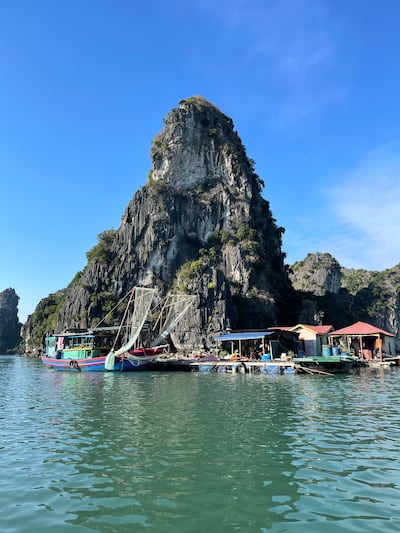The sun was beginning to set over the emerald waters of the Gulf of Tonkin in Vietnam, painting the skies in a soft palette of pinks and purples. The afternoon had been grey and cloudy, but even that could not take away from the charm of what Unesco describes in its world heritage listing as “a spectacular seascape of limestone pillars”.
I was on a cruise on Bai Tu Long Bay, a calmer neighbour of the very popular Ha Long Bay. And this was everything I had imagined from an evening in one of the country’s top tourist destinations, but without the dozens of cruise ships marring the serene vista that stretched on endlessly.
A three-hour drive away from the capital city of Hanoi, Ha Long Bay is made up of more than 1,600 islands and inlets, and magnificent limestone karsts that emerge from the water. With several exploration options available – including overnight and multi-day cruises, and day trips from Hanoi – it is no surprise the area is now teetering on the cusp of an environmental crisis, particularly with plastic pollution that has become a threat to local marine life.

Realising that the Ha Long Bay travel experience has become suboptimal – but also loathe to miss it – I had decided on an overnight Bai Tu Long Bay cruise instead. This natural extension of Ha Long Bay is still under the tourist radar, and is every bit as spectacular, while managing to stay pristine. And the cruising is quiet and peaceful, because only a handful of socially responsible cruise companies have permits to operate here.
On my cruise with Indochina Junk on the luxurious Dragon Legend, I saw no other ship on those waters. It was a far cry from overexposed Ha Long Bay, where the boats seem to compete with the rocks for space. I had chosen this company specifically for their stated commitment to sustainable tourism in what they envision as a “greener Ha Long Bay”.
After a quick transfer on a small boat from the cruise port terminal at Ha Long town, I settled into the armchair by the window of my cabin to watch the crowded pier recede from view.
Soon we were heading north-east into calmer terrain, and an awed silence descended on the restaurant lounge at the upper level where lunch was being served. Over a multi-course meal, the captain briefed our small group about the afternoon activities, which involved a trip to a hidden cave and a secluded beach along the way. But I listened to him with only half an ear, mesmerised by the dramatic, shape-shifting monoliths surrounding us on all sides.

As tempting as it was to plonk myself on the sun deck to watch the endless parade of limestone islands, the caves and kayaks beckoned. And so, we again clambered up the small boat towards Hon Co island to explore Thien Canh Son cave. After a short hike from the shore, we found ourselves in a multi-chambered world of stalactites and stalagmites, with our guide pointing out flower and animal shapes to the slightly breathless group. Descending from the cave, we walked towards the other side of the island, for a spot of kayaking on the placid waters.
There was a nip in the air by the time we got back to the Dragon Legend for an elaborate dinner, followed by games the staff conducted with great enthusiasm. I fell asleep to the soothing hum of the ship’s engines cutting through the inky darkness outside, and woke up to clear sunshine that made the landscape seem even more captivating.
Fortified with strong Vietnamese coffee, I ventured out once again, this time to see how locals live at Vung Vieng fishing village. From our ship, we took a small boat to a pier where we got on bamboo boats rowed by women whose petite size belied their tremendous strength. And off we drifted, past craggy islets, under stone arches and along the floating homes of this community.

In this small village with less than 300 inhabitants, it was delightful to see dozens of cheerful flowerpots on the front porches of the mobile dwellings. Some homes were silent, with dogs lazing under the mild morning sun, while others were wholly awake with the raucous sounds of children playing in the water. The community depends on fishing and pearl cultivation for a living, as was evident from the large nets spread carefully outside every home.
The setting was stunning, with the homes nestled in the midst of towering limestone hills, but this village at the heart of Bai Tu Long Bay represents a fast-disappearing way of life. There are only four such villages left in the Ha Long Bay region, with many forced to move inland in the past decade for economic reasons. But from my vantage point in the bamboo boat, life seemed idyllic.
Vietnamese legend has it that the mother dragon and her children descended down to earth to protect this land against invaders, and their fiery breath of jewels and gemstones turned into these gleaming, green rock formations. And while floating in the midst of these magnificent karsts formed over millions of years of geological activity, it is easy to start believing in mythical creatures and magic.




